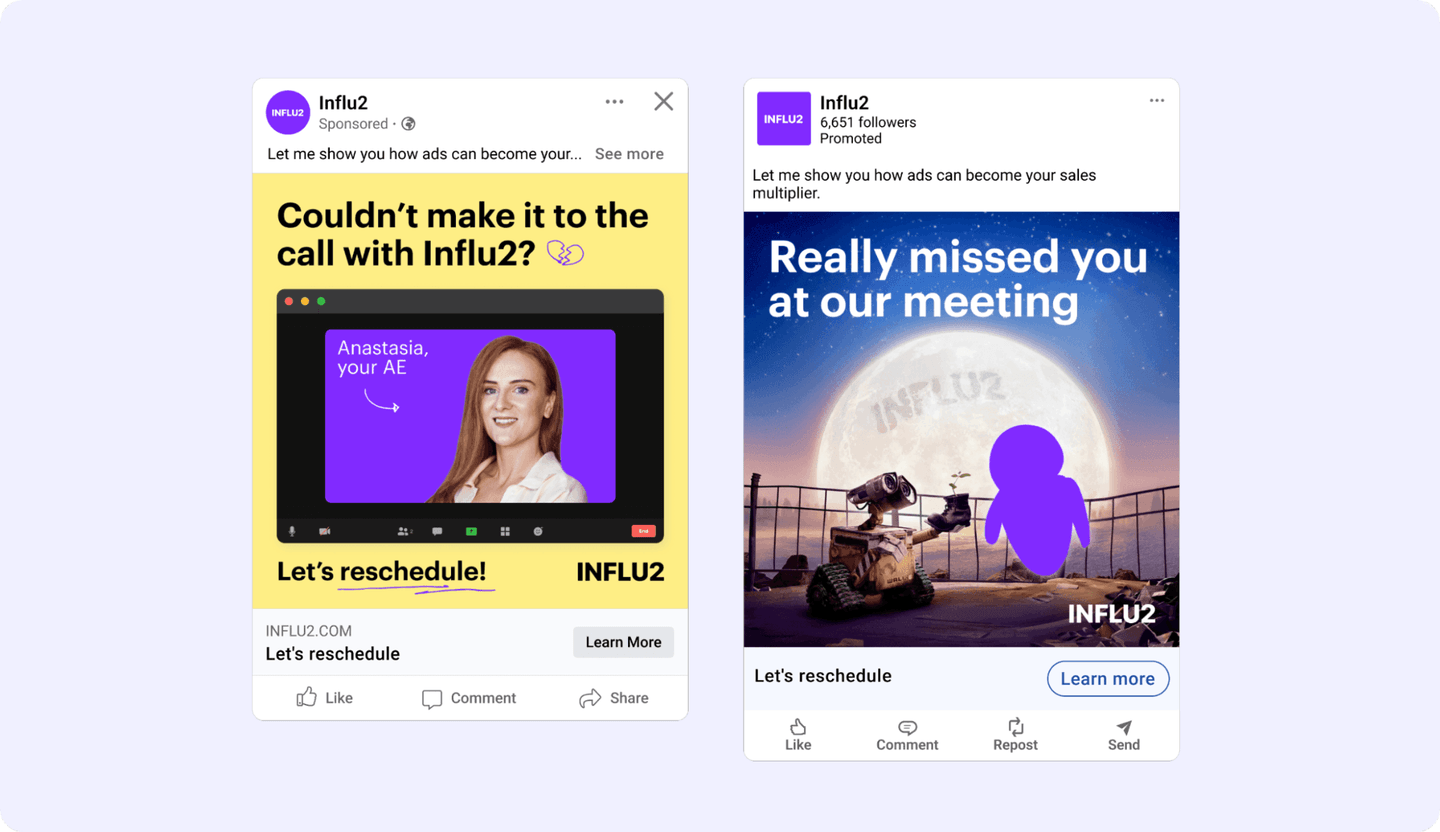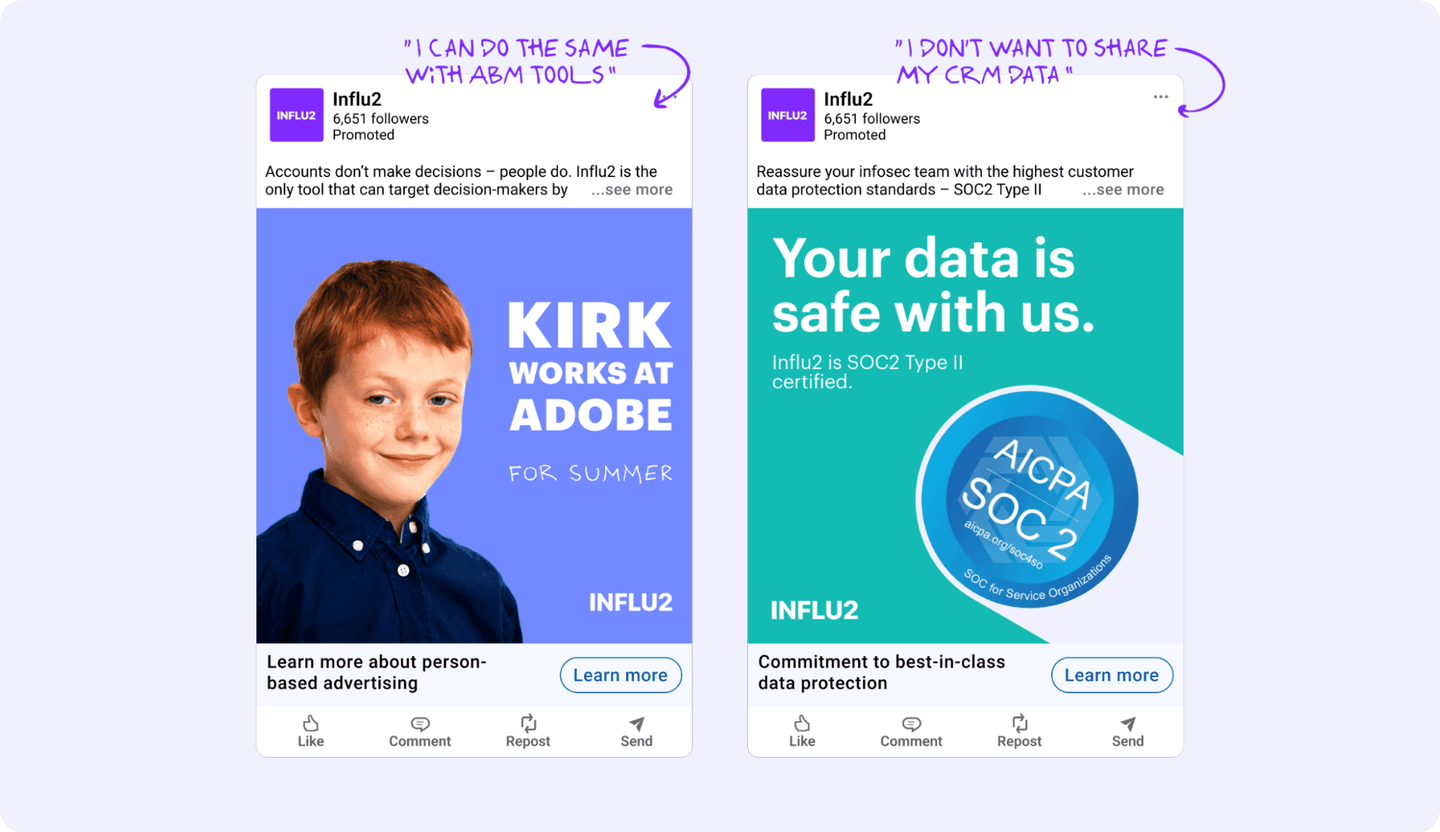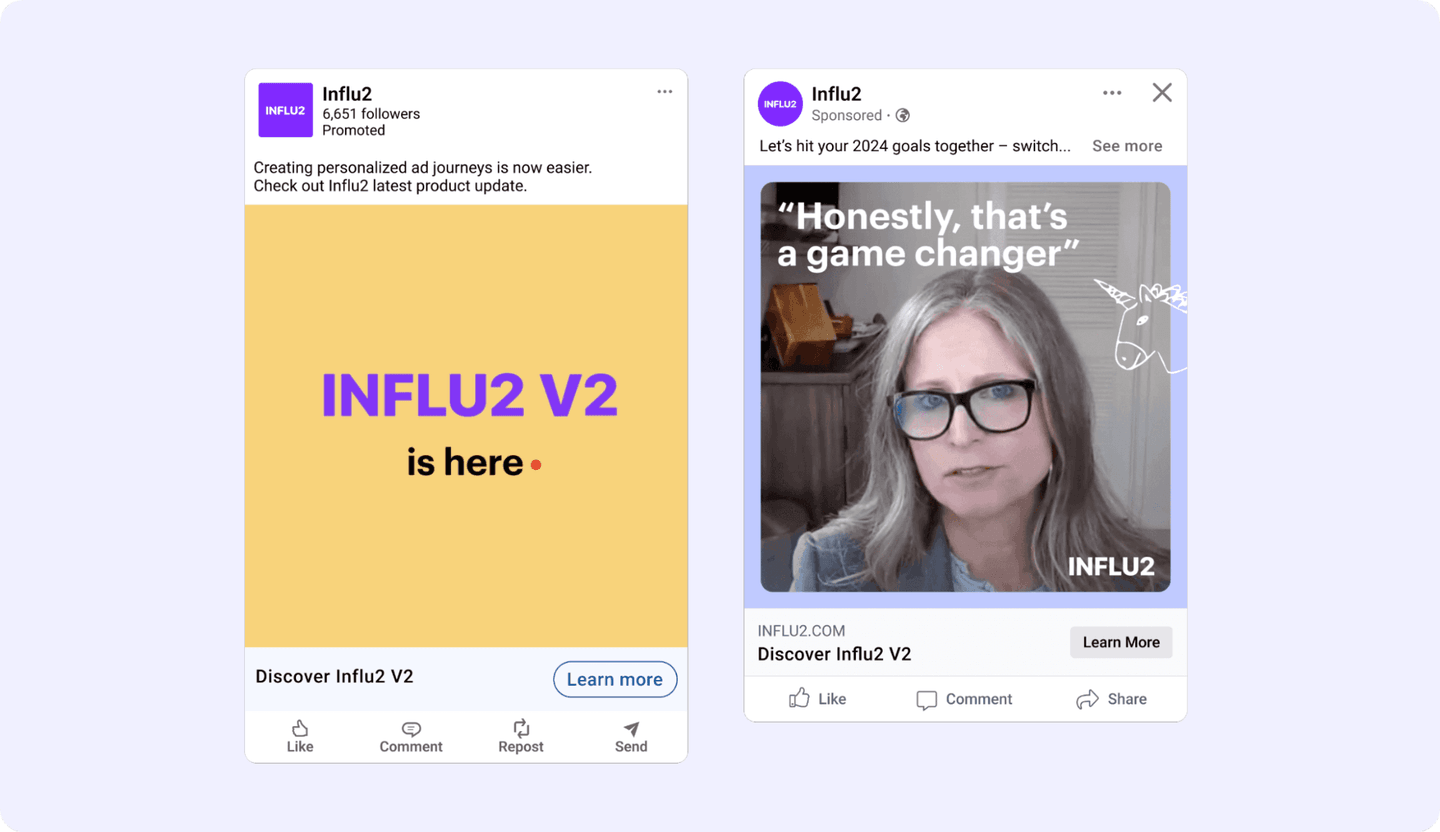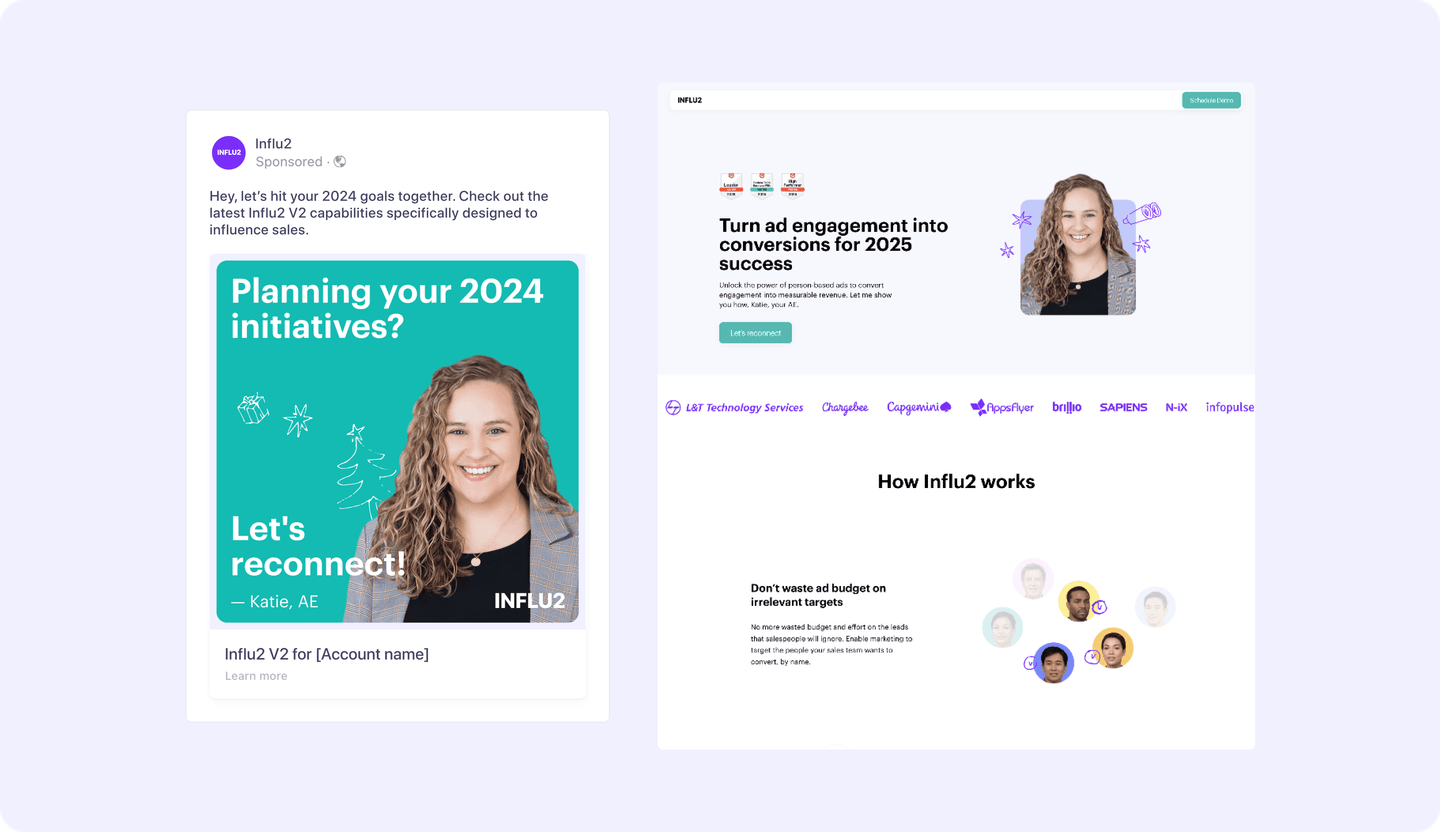13 ABM Campaign Ideas You Can Steal From Us

Ever felt like your ABM campaigns were just throwing darts at the wall, hoping something would stick?
We’ve all been there.
A truly successful ABM campaign is about precision. It’s about finding a message that evokes emotion in an audience that is primed to listen. It’s about building a strategy behind the campaign, with a clear definition of what comes after.
At Influ2, we’ve launched, tested, and optimized countless ABM campaigns. We’ve learned what works (and what doesn’t).
For us, the biggest game changer has been contact-level targeting—showing specific decision-makers a message that caters to their needs rather than blasting our tune in the hallways of the entire account (metaphorically speaking, of course).
In this article, we’re pulling back the curtain on some of our past ABM campaigns.
Whether you’re looking to drive awareness, improve meeting attendance, or accelerate deal cycles, these campaign ideas can help you build a more intentional, high-performing ABM strategy.
Here are 13 ABM campaign ideas (with ad examples)
It’s true, there’s no one-size-fits-all approach to ABM. So sorry, but copying and pasting the following campaigns won’t guarantee results.
That said, the best campaigns have one thing in common: they’re built with clear intent.
Instead of generic messaging, each campaign is designed to move key stakeholders through the funnel at the right pace.
So, as you read, take inspiration from these ideas, and then go build something worthy of the product you’re proud to be selling.
1. Top-of-funnel awareness campaigns
At this point in the ABM funnel, your prospects don’t know who you are. So, how do you grab the attention of an audience that isn’t even aware you exist?
That’s the goal of top-of-funnel campaigns. To build awareness, you could:
- Pinpoint pain points
- Speak to specific industry challenges
- Share content that’s interesting to your target audience
Ad example:

This ad speaks to a challenge that our audience faces daily: they only have access to account-level intent data that doesn’t help their team make real decisions. Then, we invite them to learn more about an alternate solution: contact-level intent.
Why this works:
- It’s based on a real challenge we know our audience is facing.
- The ad shows a promise we can deliver on: to make intent data actionable for Sales.
- On the landing page, this promise is backed up by social proof.
2. Past champion campaigns
Ever had a great champion inside a big account, and then had them move to another position or company?
While it may seem like a bad thing, those champions could be your doorway to a new account. After all, they already love your product and can vouch for its value, even as they move on to a new role.
Use data from your customer success team and sales enrichment tools like Apollo to monitor job changes and past engagement. When a former fan starts at a new company, do a bit of research—and if their new position and company still match your criteria, try to bring your product back to their mind with targeted ad campaigns.
You can even add past champions to a designated cohort in Influ2, and target them with ads like these.
Ad example:

Why this works:
- It’s ultra-personalized to the individual, and even specifically mentions they’re in a new role.
- It gives clear reasons why it’s worth reconnecting.
- It reminds them why they loved our product in the first place!
3. SDR and AE alignment campaigns
The goal of any ABM campaign is to support the efforts of your sales team. So, when your SDRs are reaching out to prospects at an account, you can target those specific individuals with ads that introduce them to your SDRs.
Ad example:

These ads put the real face of our SDRs into the sights of the person they’re targeting. Whether or not the person clicks or books a meeting from this ad, they’ll recognize this SDR the next time they send an email or reach out on social media.
Why this works:
- We build trust by putting a real face to the name, making the outreach feel personal and authentic.
- It creates consistency across channels.
- We directly link the work of Sales and Marketing, making sure each interaction reinforces the same message.
4. Meeting show-up campaigns
Getting stood up for a sales meeting sucks, but targeted ABM campaigns can help. In fact, we found that using a show-up campaign increased meeting attendance by 50%. When someone schedules a demo or a meeting with your sales team, you can automatically trigger a new campaign that helps remind them of their upcoming meeting.
Ad example:

This ad and the supporting landing page are more than just a reminder to show up: they include valuable content that will help the prospect be in the right mindset for the meeting.
Why this works:
- Again, putting a real face on this ad makes it feel more personalized, and may help remind the prospect that a real person is waiting for them on this call.
- It gives them relevant resources to prepare for this meeting.
- It gently reminds them to actually show up.
5. No-show campaigns
Of course, your sales team will still have some no-shows, no matter how many reminders you send out.
When that happens, you can trigger an ad campaign that makes them think about why they booked this call in the first place. You might try:
- Showing product value with a quick demo video
- Including some social proof (case studies and testimonials)
- Adding a CTA to book a new time
Ad examples:

These ads tug gently at the emotional string of guilt. They remind the prospect that they stood up a real person, and offer the option to reschedule.
Why this works:
- It’s not overly dramatic or condemning, but kindly reminds the person that they missed the meeting.
- The copy gives a clear reason why they booked in the first place, and why they probably want to book again.
- It uses a mixture of a real person’s face and a little bit of humor to soften the blow.
6. Adoption and expansion campaigns
Once a deal is closed, it’s time to make sure your customers are getting the most out of your product. Adoption and expansion campaigns are designed to work alongside CSMs to drive deeper engagement with your product.
This could include running ABM campaigns that:
- Highlight new features for your customers to adopt.
- Encourage users to expand their usage of your product.
- Share case studies that explain how similar users are getting the most out of your product.
Ad example:

This ad features the dedicated CSM for this account, and invites the customer to explore more features of our product. When usage data shows that a customer isn’t using your product to its fullest, you can use an ad like this to support the work of CSMs and boost product adoption.
Why this works:
- It includes a friendly face that the customer will probably recognize, since it’s their dedicated CSM.
- In addition to a CTA to book a call with their CSM, the landing page includes real use cases from other customers to help them see what they could be doing with our product.
7. Social proof campaigns
Social proof is an essential part of the sales process. It’s that inspirational message on a billboard that screams: “They did it, and so can you!”
Whether at the top of the funnel building pipeline, or later on when edging a deal to close, social proof can be the catalyst that pushes prospects to take the next step.
Within your social proof campaigns, you might include:
- Case studies that showcase real results
- Video testimonials from happy customers
- Reviews from third-party platforms
Ad example:

Why this works:
- We use the customer’s words instead of our own.
- It builds trust by highlighting real-world success stories (including actual numbers).
- It reduces skepticism by showing that others just like the prospect have achieved measurable results with our product.
8. Thought leadership campaigns
When nurturing deals or building awareness, thought leadership content can help your brand be known as an industry leader and expert.
Want to spread that content to interested prospects who haven’t made a decision yet? Use ads.
You could share industry insights, white papers, proprietary research, or webinars that help your audience learn more about the industry, and educate them on your solution.
Ad examples:

Why this works:
- We regularly produce high-value content that our audience actually wants to read (or watch), and ad campaigns help spread the word.
- It keeps our brand top-of-mind for prospects who are considering our product, but haven’t made a decision yet.
9. Trust content campaigns
The goal of trust content is simply that—to build trust. No matter the stage of the sales funnel, trust content—like case studies, playbooks, podcasts, webinars, and more—tells your audience that you are an industry leader, that you get their struggles, and that you have the experience and the insight to help them.
Basically, trust content can be split into two groups:
- Content that’s made to build trust in your product and what it can do.
- Content that helps build trust in your company as a source of information your audience can believe.
Ad example:

Real examples of how people are using your product is one of the best ways to build trust. This isn’t just a “we saw a 570% increase on a random metric” kind of article. Instead, this ad leads to a page that showcases how this customer used our product to accomplish a specific goal.
Why this works:
- It builds the foundation of how similar customers can see real success using our product.
- It highlights a video case study of a customer who maximizes their investment with us.
- The landing page includes a CTA to learn more with a demo.
10. Objection-specific campaigns
Specific people in a buying committee tend to have similar objections or concerns, whether or not they’ve voiced those to your sales team.
For example, Legal may always be concerned with the fine print in a contract. Operations may worry about compliance and data security. The CFO might object to the price and need to be convinced of the ROI.
When you’re aware of these common objections, you can preempt them with specific ad campaigns targeted to these individuals in a buying committee.
Ad examples:

Two common objections we face are teams who don’t see the difference between our product and other ABM tools, and teams who don’t want to share their CRM data. These ads directly address those objections and give clear answers.
Why this works:
- We can preempt objections before they become roadblocks in the deal cycle.
- Using Influ2, we can show these ads specifically to the people who are most likely to have these objections.
- We can use campaigns like this to get buy-in from stakeholders earlier on in the sales cycle.
11. Re-engagement campaigns
Despite the sales team’s best efforts, some prospects will slowly fade away into the night. Whether or not you want to call it “ghosting,” it’s important for the whole ABM effort to think about how you’ll deal with these prospects.
If a prospect has stopped responding to outreach from their SDR or AE, it might be time to try a more urgent message and bring your company back to their minds.
To re-engage a prospect that’s gone dark, you might try:
- Ad content that reminds them of why they were interested in the first place, such as trust content or social proof.
- Specific ads that feature the SDR or AE they’ve been talking to.
Ad example:

Why this works:
- The ad isn’t condescending and acknowledges that the SDR’s outreach may be getting lost in their inbox.
- The landing page features social proof and even a video testimonial from a happy customer.
- This campaign reminds the prospect of our product and our company—which may be all they need to re-engage in the conversation.
12. Upsell and cross-sell campaigns
Your CS team is working hard to help existing customers find the right solutions to their problems over time, including new features or higher pricing tiers that may better fit their needs as they grow.
Marketing can support those efforts by running campaigns that talk specifically about new features, product updates, or the benefits of purchasing add-ons or higher tiers.
Ad examples:

When our updated version of Influ2 was released, we created campaigns that showcased the new features and encouraged existing customers to upgrade.
Why this works:
- The ads highlighted the real reaction of customers who had joined the beta program for V2.
- It teased the idea of a new product update, giving just enough details to make them want to learn more.
13. Closed-lost campaigns
Not all closed deals are a win. In some cases, a lack of budget, a change in leadership, or a functionality gap may mean that a great account doesn’t buy.
Of course, we all know that’s not necessarily the end of the conversation. ABM teams can support Sales by re-engaging prospects who didn’t close, even targeting the specific reasons why.
Ad example:

At the end of Q4, companies are planning their budgets for the new year and thinking about what they want to invest in.
That’s why we created a campaign for closed-lost prospects who told us they didn’t have the budget for our product. That way, we’re top-of-mind while they’re planning their initiatives for the following year. You could also trigger a campaign like this for accounts who have recently received funding.
Why this works:
- It keeps our solution top of mind at a time when budgets may be opening up.
- It plays on the personal connection the prospect may have with the AE they were speaking to during the sales process.
The foundation of high-performing ABM campaigns
In all our experience running ABM campaigns, we’ve seen that there’s no magic bullet—only smart, targeted campaigns that guide prospects through every stage of their journey.
Here are the principles we live by when creating ABM campaigns:
- Precision matters: Tailoring your message to a specific audience—and especially drilling down to the individuals in your target accounts—ensures every touchpoint resonates. Meet your audience where they are in their journey, whether they’ve never heard of you before or they’re already a customer.
- Collaboration is the foundation: Our ABM campaigns don’t run in a silo. They’re part of an orchestrated ABM effort across Sales, Marketing, and CS, and run in tandem to support what other teams are doing.
- Improvement is an ongoing process: You need to keep trying new things to find what works for your brand in your audience. Analyze the results of your campaigns, note what worked and what didn’t, and you’ll have a solid foundation on how to improve.
At Influ2, we use our own platform to create targeted, contact-level ABM campaigns. Our approach isn’t about throwing generic messages into the void; it’s about crafting campaigns that speak directly to the needs of our prospects with every step.
Want to give it a try?
Schedule a demo of Influ2 and see how contact-level ABM can help you turn targeted campaigns into lasting customer relationships.

Anna's expertise has fueled 123% growth in ABM-generated revenue at Influ2, and contributed to a $52.5M Series B fundraising round at Shelf, alongside a year of 4x ARR growth. Anna is passionate about data-driven ABM campaigns that convert top-tier accounts.


